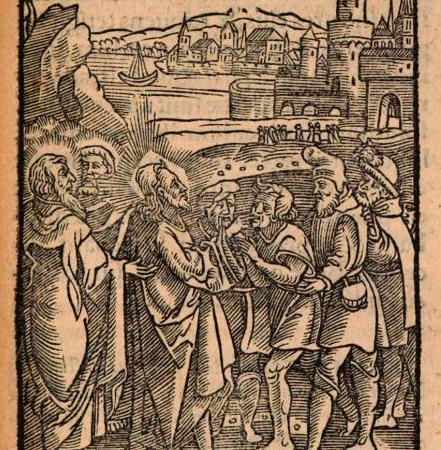
By E.J. Hutchinson
The Gospel text for the Twelfth Sunday after Trinity is Mark 7:31-37, the story of Jesus healing a man who was deaf and mute.
Then [Jesus] returned from the region of Tyre and went through Sidon to the Sea of Galilee, in the region of the Decapolis. And they brought to him a man who was deaf and had a speech impediment, and they begged him to lay his hand on him. And taking him aside from the crowd privately, he put his fingers into his ears, and after spitting touched his tongue. And looking up to heaven, he sighed and said to him, “Ephphatha,” that is, “Be opened.” And his ears were opened, his tongue was released, and he spoke plainly. And Jesus charged them to tell no one. But the more he charged them, the more zealously they proclaimed it. And they were astonished beyond measure, saying, “He has done all things well. He even makes the deaf hear and the mute speak.” (ESV)
In the model sermon on this text included in his Postilla (discussed previously here and here), Niels Hemmingsen discovers three loci or topics: the example of those who brought the man to Christ for healing; the miraculous deed performed by Christ; and the fruit or benefit of this miracle for those who saw it. In this short post, I will focus on the first.
It is significant that Christ not only healed a man, but that, in order for the man to be healed, others had to bring him to Christ. Hemmingsen finds in these baiuli (“porters”) a paradigm for the Christian life that everyone ought to imitate.
Their bringing the man to Christ shows a faith that is externalized in action, that is, in love. “[T]hey brought to him a man who was deaf and had a speech impediment,” Mark says, “and they begged him to lay his hand on him.” Hemmingsen comments on this verse:
With these few words the Christian life is described. It makes a difference for us to understand this description correctly, so that we may be able to imitate their example rightly. For, first, they recognize Christ as the Messiah. Second, they have faith in him. They declare both by their deed. For no one comes to Christ as Savior and calls upon him in prayer except for the one who believes in him. For just as no one believes except the one who hears, so no one calls upon him in prayer except the one who believes (Rom. 10). In this way, faith, conceived by the Word of life, is the salvation and righteousness of Christians.[1]
This passage, then, in addition to showing Christ’s miraculous power and tender love for man in his afflictions, also shows both faith and the fruit of faith. The faith of these porters is not the dead faith that James refers to, but Paul’s “faith working through love” in Gal. 5:6. Because I cannot state it any more clearly than Hemmingsen does, I shall just give the balance of this brief reflection to his own words.
Is their faith idle? No. Its threefold fruit is indicated here. The first is confession. For they here confess Christ by their deed and words. For just as one believes with the heart unto righteousness, so with the mouth one makes confession unto salvation. The second is calling upon Christ. For faith in Christ and calling upon him are so connected that you could sooner separate heat from fire than you could tear these two things apart from each other. The third fruit of faith is brotherly love, which these porters declare by their heart, their work, and their mouth in carrying this afflicted and wretched man to Christ.
Do you now see what kind of people these porters were? Do you see the entire Christian life depicted in their deed as on a canvas? But why was this done and written? So that you and I might have an example of piety toward God and of charity toward our neighbor. This is the form of the true Christian life. It is right, therefore, that we believe in Christ together with these men. It is necessary that we confess Christ together with them. Faith demands that we call on the same one in prayer together with them. It is fitting, moreover, that we love and help our neighbor with heart, mouth, and work by their example. What greater work of love is there, I ask, than to bring a man held captive under the Devil’s sway, afflicted and wretched, despised before men and held in complete contempt, to Christ, and to undertake such great care for the sake of another’s salvation?
Here let the rich and the poor, the noble and the lowly, city-dwellers and country-dwellers learn what is fitting for them if they do not wish to boast of the Christian name in vain. Let each one try in keeping with his own station to bring as many as possible to Christ, to call upon him in prayer, and to undertake pious concern for the sake of others’ salvation.
For righteousness and salvation, we
all must flee to Christ. Some of us will need to be carried. Thanks be to God
for those who do the carrying.
Eric Hutchinson is Associate Professor of Classics at Hillsdale College, where he also directs the Collegiate Scholars Program. His research focuses on the intersection of Christianity and classical civilization in late antiquity and early modernity. He is the editor and translator of Neils Hemmingsen, On the Law of Nature: A Demonstrative Method (CLP Academic, 2018).
[1] All translations of Hemmingsen are my own.

